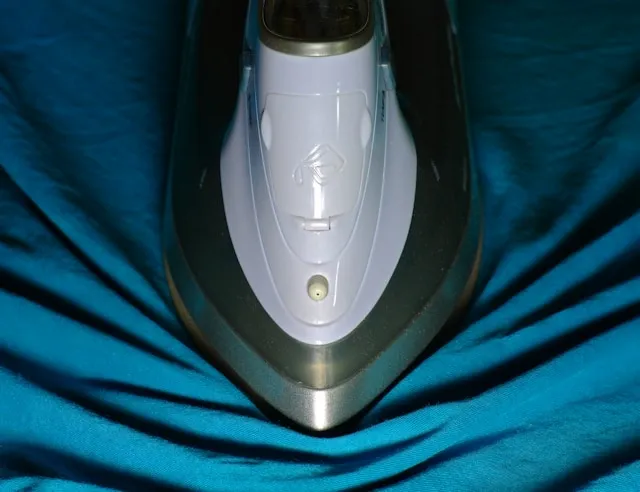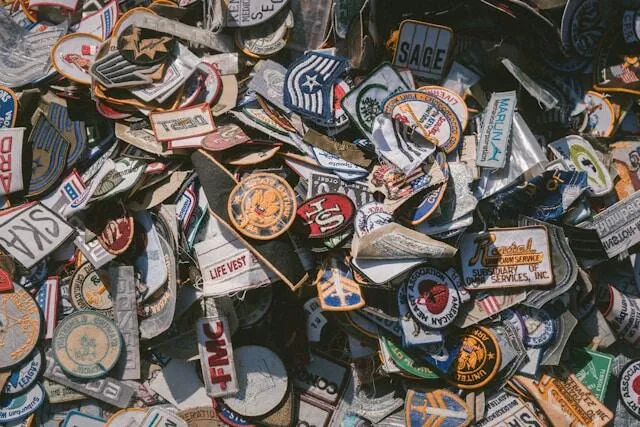How To Tell If A Patch Is Iron-On: Visual & Touch Characteristics, Inspecting The Back & More Ideas
Welcome to our detailed guide on how to know if a patch is iron-on. Whether you’re trying your hand at crafting, you’re a seasoned patch enthusiast, or you’ve simply discovered an old patch and want to know, understanding what iron-on patches look like is crucial. In this post, we explore the tactile and visual characteristics that tell you whether a patch is iron-on, so you can inspect the backing and easily tell for yourself.
With this knowledge, you will be able to select the optimal patches for your needs and get professional-looking results. Join us as we take a deep drive into the world of patch identification.

Key Takeaways
- The simplest method to tell if a patch is iron-on is to perform a visual inspection and touch test of the backing.
- A smooth, glossy backing will suggest the presence of a heat-activated adhesive, meaning it is an iron-on patch.
- Not all patches are iron-on; you will find some with sew-on, Velcro, or adhesive backings, as well as some other types.
- Other methods of testing include calling the manufacturer, performing a water droplet test, or carrying out a heat test.
- We supply high-quality custom iron-on patches with your bespoke design and full instructions on attaching so that you never need to be in doubt.
How To Tell If A Patch Is Iron-On?
Custom iron-on patches are among our most popular products, adding flair to clothing, bags, and accessories with their versatility and easy application. It’s important to understand how you can tell if a patch is iron-on to ensure you get the appropriate attachment and durable results. Here are the two most common methods of identification:
- Visual inspection: Iron-on patches usually have a shiny, plastic-like backing that contrasts with the fabric texture.
- Touch testing: Feel the patch backing with your fingertips. If it has a smooth, glossy surface, it is probably iron-on as opposed to a sew-on patch.
By applying these two methods, you can usually tell if a patch is iron-on. This will enable you to choose the appropriate method for attaching them to your desired fabric. Move forward confidently with your project to precisely enhance the look of your apparel with professional results.

What Does An Iron-On Patch Look Like?
To tell if a patch is iron-on, you need to examine the backing and look for key signs that set it apart from sew-on patches. Key features include:
- A shiny, smooth backing that resembles a thin layer of plastic or adhesive.
- A translucent or semi-transparent appearance that still allows the underlying fabric to show through.
Sew-on patches, in contrast, usually have a matte, fabric-like backing that has a tactile texture. The appearance will be solid and opaque, which looks very different to an iron-on adhesive backing.
Iron-on patches are activated by heat to achieve a secure bond with fabric when subjected to the necessary temperature. That adhesive has a glossy, translucent appearance and will create a seamless integration with the fabric once applied. You need to understand these visual and tactile differences to easily tell if patches are iron-on as opposed to sew-on. Ultimately, you have to choose the appropriate attachment method, so this understanding is crucial.
Do Iron-On Patches Have Plastic On The Back?
Iron-on patches feature an adhesive on the rear that resembles plastic to the naked eye. This backing is the medium by which the patch attaches to the fabric, as it melts when exposed to heat before resetting and adhering to your clothing or accessories. The plastic-like material usually has a smooth, glossy appearance when it is cool.
It is fairly straightforward to identify this plastic-like backing to know if a patch is iron-on. Look carefully at the back of the patch - if it has a shiny surface that differs from the fabric texture, you have a key indicator that the patch is designed for an iron-on application.
The presence of this adhesive backing makes it very easy to iron on a patch to a backpack, jacket, or other apparel. You simply position the patch, apply heat (usually from an iron) and the adhesive will activate for a secure bond to the fabric. Our custom iron-on patches are an easy way to achieve a durable, long-lasting attachment for your custom aesthetic patches with no need for sewing.
How To Inspect The Backing Of The Iron-On Patch
You need to know how to inspect the back of a patch to tell if that patch is iron-on or not. Start by looking at the rear of the patch with a bright light, like a lamp, shining directly on it. You should be looking for a glossy, shiny surface to indicate that an adhesive layer is present. This will typically be smooth and plastic-like, contrasting with the textured, matt appearance of the patch itself.
To ensure you inspect thoroughly to know if the patch is iron-on, try holding it at different angles to the light source you are using. This can be helpful in highlighting subtle differences in texture between where the adhesive should be and areas where it shouldn’t. It may also help to gently run your fingertip over the backing to feel for smoothness or stickiness, both of which suggest an adhesive is present.
If the patch lacks this glossy backing, it is likely not designed for an iron-on application. Be aware that the adhesive backing can be activated by other heat sources. Do some research if you are interested in learning how to apply iron-on patches without an iron.
Create custom iron-on patches online with our help
We make it easy to design high-quality iron-on patches and order online to get a simple solution for leveling up your style or adding branding to your garments.
Are All Patches Iron-On?
Not all patches are designed to be ironed onto fabric. There are actually a variety of patch types available, and you can customize yours to have various different backings when you order from us.
Here are some popular alternatives for you to consider:
- Sew-on patches: You need some basic sewing equipment and skills to know how to sew patches onto fabric.
- Velcro patches: These use a classic hook-and-loop fastening for easy attachment and removal.
- Adhesive patches: A simple peel-and-stick backing enables quick application, though durability is limited.
To know if a patch is iron-on or something else, you need to closely examine that backing and texture. Iron-on patches have the aforementioned glossy, shiny backing, while sew-on patches usually have a fabric back, sometimes with visible stitching holes. Velcro patches come with two complementary sides featuring the unmistakable hook-and-loop mechanism, and adhesive patches have a smooth backing that peels off to reveal a sticky surface underneath.

How To Know If A Patch Is Iron-On Or Sew-On?
Determining whether a patch is an iron-on, sew-on, or even a custom adhesive patch is critical for successful application. If you really don’t feel confident that you can identify the patch type, it may help to contact the manufacturer to get an expert answer.
If you take this approach, here are three key questions to ask:
- What is the recommended attachment method for this patch? Manufacturers usually have specific instructions for patch application that they can refer you to.
- Can you tell me what the backing material is? If they can tell you the type of backing material a patch has, this will help in identifying whether it is an iron-on patch.
- Does it require heat for attachment? Iron-on patches adhere to fabric when you activate the adhesive using heat, while sew-on patches need stitching to attach.
Clarification from the manufacturer can give you peace of mind that you have the correct application method for your patch.
Enjoy a different type of iron-on patch
If you aren’t sure about a patch you have, create your own custom vinyl iron-on patch with us for a simple, heat-activated solution that will instantly enhance your gear.
Get startedHow Do You Know If A Patch Is Iron-On? 3 Testing Methods
Determining what iron-on patches look like is crucial for identifying the type of patch you have. We sell custom wholesale patches with generous discounts so that you can get the patch type you need with your bespoke design for any purpose. But if you are uncertain about the patch backing that you have, there are some tests you can perform to explore more deeply.
The tests you can try are as follows:
- The water droplet test
- The heat response test
- Examining the thickness of the patch edges
By employing these testing methods, you can confidently determine if a patch is iron-on. Let’s look closely at what you need to do.
The Water Droplet Test
In some cases, all you need is a single drop of water to determine whether there is adhesive on the back of a patch. Drip the tiny droplet onto the patch’s backing, preferably on an inconspicuous area, and allow that droplet to sit for a moment. Observe what happens, as the outcome could be either of the following:
- The droplet remains on the surface, indicating the presence of an adhesive that requires heat for activation.
- The droplet soaks into the patch, suggesting there is no adhesive and you have a sew-on or other type of patch.
By carrying out this straightforward test, you can confidently assess whether your patch is iron-on so that you can take the appropriate path forward for applying it to your apparel.
Heat Response Test
To safely conduct a heat response test to tell if a patch is iron-on, you will need a low-heat source like a hair dryer or an iron on its lowest setting. Place the patch on a heat-resistant surface with the back facing upwards. Hold the heat source several inches away and take care not to directly apply heat or excessive temperature.
Gradually apply warmth to the patch backing for a few seconds, watching closely for any changes on the surface. If it is an iron-on patch, the adhesive will activate and you will see it start to soften. Try not to overheat the patch as you could damage it or weaken the adhesive for when you want to apply it for real.
This method should be approached with care as there are always risks to using heat. But, by applying it safely, you should be able to get a conclusive outcome as to whether or not you have an iron-on patch.
Typical Edge Thickness For Iron-On Versus Other Patch Types
The thickness of a patch can be a way to know if it is iron-on or something else. Generally speaking, iron-on patches have a thinner edge compared to sew-on patches. You can use a rule or calipers to gauge the width of the patch’s edge. If it has a sleek, uniform edge, this could be evidence of an iron-on patch as it relies on the adhesive backing rather than a thread for attachment.
Sew-on patches, meanwhile, often have a thicker edge because they need to provide space for the stitched border. Comparing edge thickness of the patch in question to known examples of iron-on and other patch types could help you make an educated guess about the type of backing you are working with. Alongside other tests and assessment methods, this provides a straightforward way to know if a patch is iron-on so that you can work out how to attach it to your apparel.

Why Isn't My Iron-On Patch Sticking?
Sometimes, iron-on patches fail to stick, even if you follow the correct process for how to iron-on patches to jeans and other garments. If you have already used methods to tell if the patch is iron-on, and confirmed that it is, here are some tips that might help you get it right:
- Heat level: Make sure your iron is set to the appropriate temperature for the patch and the fabric and apply firm pressure whilst heating.
- Duration: Patch instructions usually dictate a minimum time for heat application to activate the adhesive, so try ironing for a little longer.
- Fabric compatibility: Some materials don’t adhere well to iron-on patches, so make sure the patch and the fabric are a good fit.
- Alignment: Misaligned patches may not adhere evenly, so double-check the positioning before you apply the heat.
- Dirt or residue: If the patch and/or the fabric are not clean, it could hinder adhesion. Clean both surfaces before applying the patch.
Explore whether any of these issues could be the cause of your iron-on patch failing to stick. Follow the advice we have provided to increase the chances of success.
Enjoy a beautiful addition to any garment or accessory
For a touch of warmth and elegance on your apparel, consider our custom flower iron-on patches to bring a splash of color and style that is easy to apply.
Frequently Asked Questions About How To Tell If A Patch Is Iron-On
How To Tell If A Patch Is Iron-On?
The simple answer is to examine the back of the patch. If it has a smooth, glossy surface, this might indicate the presence of an iron-on adhesive. A matt, textured surface probably suggests a sew-on patch.
Are All Patches Iron-On?
No, there are various backing types of patches, and we supply many of them with our custom patch service. Alternatives include sew-on, Velcro, and adhesive patches, and there are more besides.